This website is supported by its readers. If you click one of my links I may earn a commission. I am also a participant in the Amazon affiliates program and I will also earn a commission from qualified purchases.
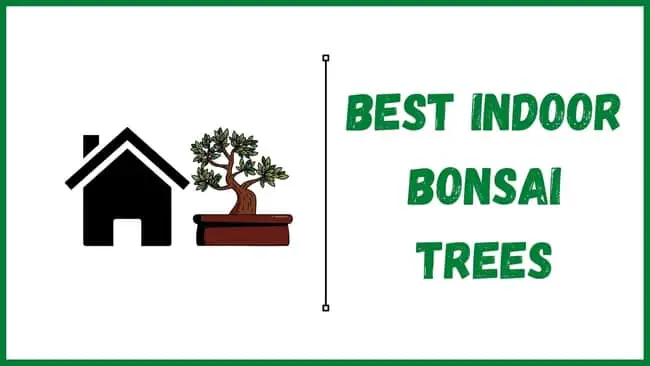
Google pictures of bonsai trees and it’s super common to find these trees growing indoors, in offices, on window sills and even in bathrooms (seriously if you do this…why?!). That being said, is growing bonsai trees indoors really a feasible option? And what exactly are the best indoor bonsai trees?
Ficus, Jade, Fukien Tea, and Elms species are the best indoor bonsai trees. These trees are low maintenance, will not die if you forget to water them, and can be grown successfully with a grow light. Succulents and other tropical species also thrive in indoor conditions.
Ensure however you avoid hardy species such as Willow, Juniper, Scots Pine, and others that thrive in outdoor conditions.
So what are the differences between these trees? And which of these tree species would be the undisputed best indoor bonsai tree? Keep reading to find out more!
Just a quick heads up, over the past three years of running Plantpaladin, hundreds of people have asked for product recommendations. As such, You can find my favorite indoor bonsai tree here (link takes you to Bonsaiboy), my favorite outdoor bonsai tree (link takes you to Bonsaiboy), or have a look at all the products I recommend here.
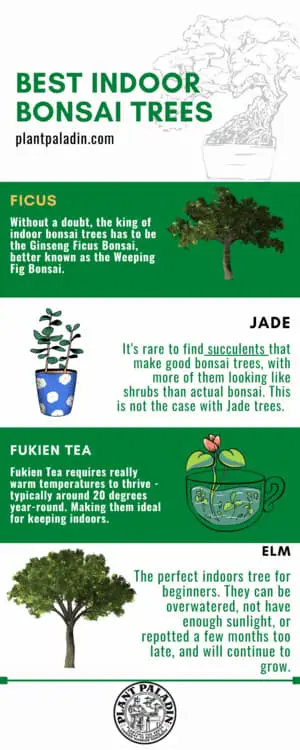
Ficus
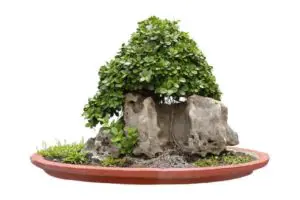
Without a doubt, the king of indoor bonsai trees has to be the Ginseng Ficus Bonsai, better known as the Weeping Fig Bonsai.
Probably the best thing about keeping a Ficus bonsai indoors is that, unlike other species, its light, water, and temperature requirements are much less than other varieties.
On top of this, Ficus unlike other trees can be completely propagated either from a cutting or a seed indoors.
Ficus bonsai are also evergreen ensuring that you will have a bright green canopy through the year when keeping your tree.
What is the best Ficus species to keep indoors?
Ficus bonsai come in literally thousands of different varieties, without a doubt however the best would have to be the Ginseng Ficus bonsai.
This is the most popular variety of ficus out there, meaning the wealth and depth of information available in caring for these trees is huge.
On top of this, Ficus bonsai is much more forgiving hen some other Ficus varieties.
Another good Ficus to opt for would be Ficus Benjamina.
Advantages and disadvantages of keeping a Ficus indoors
Like all plants, Ficus has several advantages and disadvantages, especially when being kept indoors.
The main advantages of Ficus bonsai are:
- Pest repellent – Ficus bonsai are less likely to get infected by bugs than other types of bonsai species due to the natural protection they contain in their leaves.
- Smaller light requirements – Unlike other bonsai trees that require a ton of sunlight, Ficus only need around 4 hours of direct sunlight per day – this can be easily provided from a grow light
- Can be propagated – Ficus bonsai can also spend its entire life indoors meaning you won’t have to worry about moving this tree outdoors at any point during the year.
The main disadvantages of Ficus bonsai are
- Slow growing – Ficus only tends to grow about 3 to 5 inches per year on average, meaning it can take years to get a larger-sized bonsai tree.
- A long time to train – As the tree is so slow-growing, activities such as wiring, pruning, and trunk development will take longer to complete than it would on other species.
How to care for ficus bonsaI trees indoors?
If you are interested in learning more about how to specifically care for ficus, I’ve enclosed a table below which should help:
Ginseng Ficus Bonsai tree Requirements | Explained |
Water | Once per day in the spring-summer or if kept indoors. Once per week if kept outdoors during the winter. Only water if dry to touch. |
Sunlight | 4 hours of direct sunlight in the summer. LED grow light can also be used. |
Temperature | Between 60 degrees F and 100 degrees F |
Fertilizer | Fertilize 18 times per year, twice per month between spring and summer. Once per month in the fall and winter |
Repotting | Once every 2 to 3 years in the first 10 years. You can then report once every 5 years |
Placement | Can be placed outdoors in direct sunlight or indoors in a bright spot. |
Wire type | Both copper and aluminum wire can be used. |
Time to grow from scratch into maturity | 8 to 12 years to reach full maturity |
Potting soil | An inorganic Akdama, volcanic ash soil mix works best. |
Growth type | Slow growing, averaging 3-5 inches per year |
Size | Average store-bought trees are size is one or two-handed bonsai trees - 3 to 10 inches in size, 2 to 8 inches wide |
Lifespan | 50 to 150 years |
Fruit | figs |
Jade
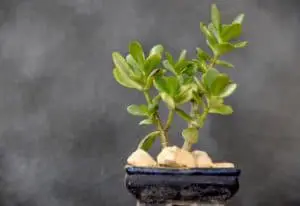
If Ficus is the world champion of the best indoor bonsai trees then the silver medallist would have to be the Jade bonsai.
It’s rare to find succulents that make good bonsai trees, with more of them looking like shrubs than actual bonsai.
Not the case with Jade trees, whose thick, tough, water-filled branches give the perfect material to work with to form aesthetically pleasing bonsai trees.
As Jade is used to being grown in warmer climates, it does not suit the cold or big jumps in temperature – making them the perfect species to be kept indoors.
On top of this, being succulents means it can be very easy to overwater so ensure you only water once per day or wherever the topsoil is dry to touch.
What is the best Jade species to keep indoors?
Of the 200 varieties of Jade plants, Dwarf Jade is the best Jade species to use for bonsai indoors. Its dense thick leaves mean that you will have actual foliage to train rather than other varieties which can often be more difficult to work with.
Advantages and disadvantages of keeping a Jade bonsai indoors
The main advantages of keeping a Jade bonsai indoors are:
- Require less water than other species – Meaning you can have a set and forget attitude with these trees for a few days at least.
- Grow in any soil mix – Unlike other species and mix of organic and inorganic soil mix will work well.
- Very forgiving – These trees are perfect for beginners as they can be quite hard to get wrong.
The main disadvantages of keeping a Jade indoors are:
- Easy to overwater – These plants are built to not need a lot of water, and so can be very easily overwatered. Ensure then that you only water when the topsoil is dry. Once per or every few days will usually be enough.
- Need a lot of sunlight – While these are good trees to grow indoors, they do require a lot of sunlight meaning growing light will almost certainly have to be sued.
- Slow growing – Dwarf jade, in particular, is very slow-growing, adding only 3 to 5 inches per year
How to care for Jade bonsaI trees indoors?
Jade Bonsai tree Requirements | Explained |
Water | Once per day in the spring-summer or if kept indoors. |
Sunlight | 4 hours of direct sunlight in the summer. LED grow light can also be used. |
Temperature | Between 40 degrees F and 100 degrees F |
Fertilizer | Once per month in the spring and summer - avoid in fall and winter. |
Repotting | Once every 2 to 3 years in the first 10 years. You can then report once every 5 years. Undertake to repot in spring. |
Placement | Mainly indoors, unless you live in a hot climate. |
Wire type | Both copper and aluminum wire can be used. |
Time to grow from scratch into maturity | 10 to 15 years to reach full maturity |
Potting soil | An inorganic Akdama, volcanic ash soil mix works best. |
Growth type | Slow growing, averaging 3-5 inches of growth per year. |
Size | Average store-bought trees are size is one or two-handed bonsai trees - 3 to 10 inches in size, 2 to 8 inches wide |
Lifespan | 50 to 150 years |
Fruit | None |
Fukien tea
Another fantastic tree that has to be in consideration for the best indoor bonsai trees is the Fukien Tea bonsai.
Fukien Tea requires really warm temperatures to thrive – typically around 20 degrees year-round.
With most of us living in climates that come nowhere near that, these trees are perfect to be kept indoors.
The only caveat to this with Fukien Tea would be this tree has to be kept moist, as its roots thrive in moister soil meaning regular watering is a must.
What is the best Fukien tea species to keep indoors?
Unlike other tree types, Fukien Tea only really comes in two varieties.
Having small leaves and having large leaves.
The best variety would be to invest in Fukien Tea that has the smaller leaves which me
Be easier to manage and maintain when growing them indoors.
Advantages and disadvantages of keeping a Fukien indoors
The main advantages of keeping a Fukien Tea bonsai indoors are:
- Need heat – Fukien tea bonsai need a lot of heat that most of us, living in hardier climates will not be able to thrive. As such, keeping these trees indoors is the perfect solution
- Can be trained easily – Fukien tea are amongst one of the most popular tree species to keep for bonsai due to being easy to work with. They heal well on intense activities such as repotting and can be very easy to grow for beginners.
- A lot of information – As these trees are so commonly used in bonsai, the breadth of information out there for keeping these trees is huge
Disadvantages of keeping Fukien tea bonsai indoors include:
- A lot of sunlight – These trees require at least 4-6 hours of direct sunlight per day – meaning a grow light will be essential in growing these trees.
- Keep them moist – Whilst they can be grown in most soil types, the soil must be kept moist most of the time to have a healthy tree
- Insects – Most soil conditions can lead to pests like scale, spider mites and aphids attacking your tree. Root rot may also occur if you overwater the tree.
How to care for Fukien Tea bonsaI trees indoors?
Fukien Tea | Requirements |
Water | Water if dry to touch - once per day as a minimum. Water once per week in the winter. |
Sunlight | 6 hours of direct sunlight. Place near a window if kept indoors |
Fertilizer | Once per month in the spring and summer - avoid fertilizing in the winter. |
Growth rate | Slow; 1 to 5 inches of growth per year. |
Repotting | Once every 2 years |
Elm
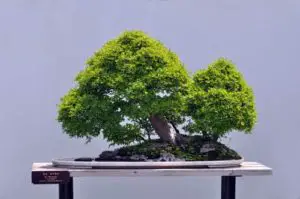
If this post was not on the best indoor bonsai trees but the most beginner-friendly bonsai trees, then without a doubt Elm species and more specifically Chinese Elm would be top of the list.
That being said, Chinese Elm makes for a fantastic indoor bonsai trees species that is very forgiving,
They can be overwatered, not have enough sunlight, or repotted a few months too late, and will continue to grow.
Elms also have the unique ability to grow both indoors and outdoors meaning you will have a bonsai tree that can stay with you if your life situation changes.
What is the best Elm species to keep indoors?
Both Chinese and Japanese Elms are the best subspecies of Elms to keep indoors. These species in particular are amongst the oldest species that have been used in bonsai tree keeping since its inception.
Other fantastic varieties to use for indoor bonsai include Florida, America, and Cedar Elm species.
Advantages and disadvantages of keeping an Elm bonsai indoors
The main advantages of elm bonsai are:
- Very fast-growing – Chinese elm in particular can grow between 12 and 36 inches per year.
- Can be kept indoors and outdoors – Whilst these trees are grown indoors, they can also be moved outdoors making it the perfect hybrid tree.
- Very beginner friendly – A very forgiving tree with a lack of watering, pruning, or general care all not phasing this tree.
- A lot of knowledge – As Chinese Elms are so popular the amount of knowledge on keeping these trees is vast.
The main disadvantages of Elm bonsai are:
- Can attract pests – Spider mites in particular love Chinese Elms and so regular insecticide either natural or inorganic needs to be used to remove
- A lot of trimming – As the tree is so fast-growing, you will need to undertake a lot of pruning.
How to care for Chinese Elm bonsaI trees indoors?
Chinese Elm Bonsai tree Requirements | Explained |
Water | Once per day in the spring-summer or if kept indoors. Once per week if kept outdoors during the winter. Only water if dry to touch. |
Sunlight | 6 hours of direct sunlight in the summer. LED grow light can also be used. |
Temperature | Between 60 degrees F and 100 degrees F |
Fertilizer | Once per month during the spring and summer. No fertilization is required in the fall or winter. |
Repotting | Once every 2 to 3 years in the first 10 years. You can then report once every 5 years |
Placement | Can be placed outdoors in direct sunlight or indoors in a bright spot. |
Wire type | Both copper and aluminum wire can be used. |
Time to grow from scratch into maturity | 8 to 12 years to reach full maturity |
Potting soil | An inorganic Akdama, volcanic ash soil mix works best. |
Growth type | Fast-growing, averaging 12 to 36 inches of growth per year. |
Size | Average store-bought trees are size is one or two-handed bonsai trees - 3 to 10 inches in size, 2 to 8 inches wide |
Lifespan | 50 to 150 years |
Fruit | None |
Olive
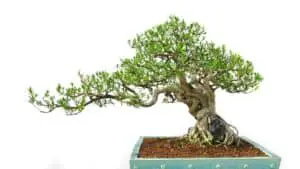
Olive trees can be used both indoors and outdoors so make for fantastic indoor bonsai trees.
These trees are Mediterranian meaning these bonsai will thrive in warmer conditions.
This makes them ideal for keeping in an indoor space with the heating on.
Olive bonsai are also relatively slow-growing, adding only 2 to 5 inches of growth per year meaning that you will not need to prune them as regularly as some of the other species on this list.
What is the best Olive bonsai species to keep indoors?
The Wild Olive, better known as Olea Sylvestris, is the best olive species to be used in bonsai indoors. This tree prefers warmer temperatures and its tough dense branches and small leaves make it ideal for bonsai keeping.
Olive bonsai come in well over 130 sub-species, so there is plenty of variety of the wild olive variety is not one you want to opt for.
Advantages and disadvantages of keeping an Olive bonsai indoors
The main advantages of Olive bonsai are:
- Clean the air – Should you keep your olive bonsai indoors, it can help with purifying the air
- New roots – Olive trees bonsai can easily create new roots, making it much easiest to create deadwood such as nebari.
- Longevity – Olive tree bonsai comes from olive trees that can live for thousands of years if cared for properly.
- Fruit-bearing – olive tree bonsai can also bear olive fruit
The main disadvantages of olive bonsai are:
- Slow growing – Olive tree bonsai typically only grow a few inches every year meaning they can take a while to shape
- Tough wood – Olive tree bonsai has tough wood meaning stronger copper wire has to be used when wiring – this is more likely to lead to breakages in the mark
- Sunlight requirements – these trees require a lot of sunlight. If you keep these indoors for years at a time, their health will start to suffer.
How to care for Olive bonsai trees indoors?
Olive Bonsai Care | Explained |
Water | Check once per day if the soil is dry to the touch. If so, the olive tree needs watering. Non-bonsai olive trees require watering only once per week, but bonsai trees typically will need more water so once per day should be ideal. Only water once per week during the winter in cold temperatures. |
Sun | 4 to 8 hours of direct sunlight in the summer |
Temp | 0-95 degrees Fahrenheit ( -12 to 35 degrees celsius) |
Local | Both indoors and outdoors in a spot that gets a lot of sunlight |
Food | Fertilize once per month during the summer months. No fertilizing is required in winter. |
Growth | Slow growing - 2 to 4 inches per year. |
Money tree
Money trees are unique in the sense that instead of just being one subspecies (or varieties of a sub-species) they consist of 5 different species of tree.
Pumpo, Saba Nut, Malabar Chestnut, Provision tree, and Guiana Chestnut all make up the money tree bonsai species.
The one thing they all have in common is the old folktale of bringing prosperity to the home they live in.
Now whilst caring for five different sub-species might seem challenging, the truth is all of these different varieties are very easy to care for, sharing a lot of the same properties.
Most importantly, these trees can be easily grown indoors and are the staple of many indoor bonsai enthusiasts.
What is the best money tree species to keep indoors?
Whilst all 5 of the money tree sub-species can easily be grown indoors, the best would have to be the Malabar Chestnut which thrives in moist humid conditions that indoor conditions provide.
Advantages and disadvantages of keeping a Money Tree Bonsai indoors
The main advantages of money tree bonsai include:
- Fast-growing – Meaning you won’t have to wait around for long periods before this species grows
- Not much watering – overwatering will cause these leaves to become too large and so watering only when the topsoil is dry should be undertaken.
- Braided trunk – The trunk of the money tree is braided opting for a more aesthetically pleasing looking tree that can stand out in competitions.
The main disadvantages of money tree bonsai include:
- Trunk development – Due to the braided design of the trunk, general trunk development can be more complicated
How to care for money tree bonsaI indoors?
Money Tree Bonsai Requirements | Explained |
Water | Once per day in the spring-summer or if kept indoors. Once per week if kept outdoors during the winter. Only water if dry to touch. |
Sunlight | 6 hours of direct sunlight in the summer. LED grow light can also be used. |
Temperature | Between 60 degrees F and 100 degrees F |
Fertilizer | Once per week from spring to autumn. |
Repotting | Once every 2 to 3 years in the first 10 years. You can then report once every 5 years |
Placement | Can be placed outdoors in direct sunlight or indoors in a bright spot. |
Wire type | Both copper and aluminum wire can be used. |
Time to grow from scratch into maturity | 8 to 12 years to reach full maturity |
Potting soil | An inorganic Akdama, volcanic ash soil mix works best. |
Growth type | Fast-growing, averaging 12 to 36 inches of growth per year. |
Size | Average store-bought trees are size is one or two-handed bonsai trees - 3 to 10 inches in size, 2 to 8 inches wide |
Lifespan | 30 to 50 years |
Fruit | None |
Snow Rose
So if you are interested in an indoor bonsai tree that also has bright flowers then look no further than the Snow Rose bonsai.
Also knowns as the Japanese Boxthorn or Snow Goose, its bright white flowers do add a pop of color during the winter months.
These trees are also coniferous staying leafy year-round and can also be kept both indoors and outdoors.
What are the best Snow rose tree species to keep indoors?
Snow Rose is unique in that not only are they subspecies of Serissa, but also have hundreds of subspecies ranging in color.
If you would like Snow Rose that does not have white flowers but a different color then you can very easily pick these up.
Advantages and disadvantages of Snow Rose bonsai indoors
The main advantages of keeping snow rose bonsai indoors include:
- Can be kept outdoors – This plant can easily be moved between indoors and outdoors making it incredibly versatile
- Aesthetically pleasing – This bonsai is very popular mainly due to the bright small flowers that bloom.
The main disadvantages of keeping Snow Rose bonsai indoors include:
- Only flowers during winter – If you are adamant that you only want to grow this bonsai tree for the flowers, just be aware that it only blooms in the winter meaning you won’t get flowers year-round.
- Might not bloom – Similar to this, if you are keeping a Snow Rose indoors, these bonsai require the seasons to grow and bloom their flowers, keeping these trees indoors and using a grow light might not get the same results.
- Harder to care for – Unlike the other trees on this list, Snow Rose is more difficult to care for and is sensitive to larger changes in temperature and light. Only grow if you have a few years of experience under your belt.
How to care for Snow Rose bonsaI indoors?
Serissa | Requirements |
Water | Water if dry to touch - once per day as a minimum. Water once per week in the winter. |
Sunlight | 6 hours of direct sunlight. Full Sun required. Place indoors should temperatures drop below 10 degrees for winter. |
Fertilizer | Twice per month in the spring and summer - avoid fertilizing in the winter. |
Growth rate | Slow; 1 to 5 inches of growth per year. |
Repotting | Once every 2 years |
Dwarf Umbrella
The Dwarf Umbrella, also known as the Hawaiian Umbrella is a tropical bonsai species that is ideal for keeping indoors.
This is mainly because it thrives in low light, low humidity conditions make it ideal for apartments and flats.
On top of this, the Dwarf Umbrella also has a large canopy of small leaves with thin branches making for a very distinct-looking indoor bonsai tree.
What are the best Dwarf Umbrella tree species to keep indoors?
The Dwarf Umbrella is a singular species and so will be the best species for keeping indoors. A closely related alternative would be the Schefflera actinophylla however this species will need to be pruned more due to its larger leaf growth.
Advantages and disadvantages of Dwarf Umbrella bonsai indoors
Advantages of Dwarf Umbrella bonsai are:
- Low light requirements – This tree only needs about 4 hours of sunlight per day and can be easily grown with a grow light
- Fast-growing – Meaning that you can have a relatively large growing species in a short space of time.
- Low humidity – Making indoor locations, particularly garages or cold spots ideal location to keep these trees indoors.
The disadvantages of Dwarf Umbrella bonsai include
- Difficult trunk – As the trunk for this tree is much smaller and thinner when compared to other varieties, it can prove a challenge to create certain styles such as sumo or cascade bonsai with these
- Pest infestation – The larger leaf canopy and intertwined branches/trunk means it is easier for pests such as whiteflies and aphids to nest.
How to care for Dwarf Umbrella bonsaI indoors?
Dwarf Umberella | Requirements |
Water | Water once to twice per day. Ensure topsoil does not dry out. |
Sunlight | 4 hours of direct sunlight. Grow light can be used. |
Fertilizer | Once per week in the spring and summer - avoid fertilizing in the winter. |
Growth rate | Slow; 1 to 5 inches of growth per year. |
Repotting | Once every 2 years |
Placement | Indoors only |
Growth Rate | Fast growing, adding 12 to 26 inches of growth per year |
What other bonsai species can you grow indoors?
So while the above 8 bonsai trees are easily the best indoor bonsai trees you can purchase, there are a few other species I wanted to highlight briefly that you can also consider.
These species are not as common as the above species and so can make your bonsai collection stand out
These species include:
Japanese maple
If you want an indoor bonsai tree with bright red leaves and a true miniature tree then Japanese Maple bonsai might be the best choice for you.
Japanese Maple needs to be kept moist year-round and have larger water needs than other varieties.
They do however require less sunlight than other varieties meaning they are ideal to be kept indoors.
Japanese Maple can be kept either indoors or outdoors.
Flowering Brazilian Rain bonsai
If your home is kept warm year round then the perfect indoor bonsai tree for you to opt for would have to be the Flowering Brazilian Rain bonsai tree.
Originating from the rainforests of Brazil, these trees love warm conditions and fail to thrive in cooler climates.
Keeping these trees moist and warm will be essential to growing them successfully indoors.
These trees also do not like bright light and so indoor conditions are perfect for them.
Sweet arcadia bonsai
Sweet Arcadia is a subspecies of the Arcadia and Wattle varieties of trees.
Now, these trees are incredibly common with over 1200 different varieties.
These trees prefer warm sunny conditions to thrive and work well when kept outdoors for summer and indoors for winter.
Luckily using artificial LED light can also work wonders on growing these trees indoors if need be.
If growing from scratch, ensure you use scarification to help propagate.
Sweet Plumb
A fantastic alternative to Chinese and Japanese Elms and a species that is not as prevalent as those in bonsai collections has to be Sweet Plumb bonsai.
This species can be kept indoors year-round.
Ensure you keep near a southern or west-facing window. Avoid direct sunlight however as this can be dangerous for the plant
Keeping this tree in a temperature-controlled conservatory will work best.
Ponytail palm
Finally, if you want your bonsai tree to truly be unique, then look no further than the ponytail palm bonsai.
This species has long thin leaves like that of a dragon tree but still has the trunk structure to grow as a bonsai tree.
Ponytail Palm will thrive indoors, just ensure you do not overwater this tree which can be a common occurrence – only water when dry to touch.
How to care for a bonsai tree indoors?
Indoor bonsai species can easily dry out or not get enough sunlight so check the top soil daily to see if it needs water and move to a south-facing window to get enough sunlight.
Keeping indoor bonsai at room temperature and not having large shoots in temperature will also prove beneficial.
What bonsai trees should not be kept indoors?
Junipers, pines, willow, oak, and Scots Pine bonsai should not be kept indoors. This is because these trees require a lot of sunlight (in some cases more than 8 hours per day) and colder temperatures to thrive.
How to give indoor bonsai trees sunlight?
If your indoor bonsai tree is struggling to get enough light, place it near a south or west-facing window. Alternatively invest in an LED grow light, that contains the full light spectrum to best ensure your indoor bonsai tree gets enough sunlight.
Best indoor bonsai tree with flowers
The best indoor bonsai tree with flowers is the Snow Rose Bonsai. This tree produces small bright white flowers that bloom during the winter. Alternately invest in Fukien Tea which also flowers.
To read up more on bonsai tres with white flowers – check out my post here.
Avoid Orchids however at all costs.
Best indoor bonsai tree with Fruit
Olive bonsai can produce small edible fruit and can easily be grown indoors. Most fruiting bonsai however cannot be grown indoors due to their light needs.
To read up more on bonsai tres with fruit – check out my post here.
What is the best indoor bonsai tree for beginners?
Ginseng Ficus bonsai and Chinese Elm bonsai are the best indoor bonsai tree species for beginners. These species are easy to train, and will not perish immediately if you fail to water, train or provide enough sunlight for these trees.
Survey on the best indoor bonsai trees?
Finally, I wanted to finish up and ask a few experts what the best indoor bonsai trees are.
First, on a local visit to my botanical gardens I asked one of the members of staff what they feel are the best indoor bonsai tres are:
“Ficus jade and Chinese elm are good bonsai trees to grow indoors”
I also undertook a quick survey of 10 plant paladin readers who keep their bonsai trees indoors and asked them what the best indoor bonsai trees were.
Here are the results:
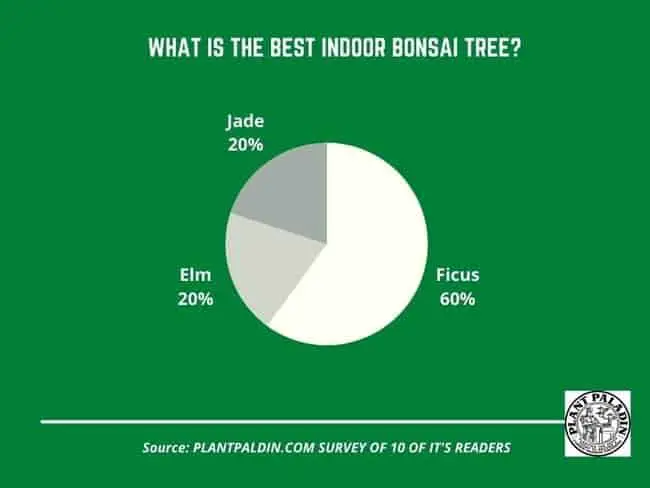
My top picks for the gear you will need!
So like I mentioned earlier, over the past three years of running PlantPaladin, hundreds of people have asked me for my recommendations on the best bonsai gear on the market.
Having spent thousands of dollars on bonsai items these past few years and tested at least 100 bonsai-specific products, I’ve listed my favorite products below – All of which I highly recommend and think you can get great value.
They can purchase directly by clicking the link to take them to Amazon.
Bonsai Tool Set: One of the significant challenges I’ve had is finding a toolset that was not only durable but didn’t break the bank. SOLIGT has recently developed a fantastic bonsai tool set that covers all the tools you need to trim, prune, and repot your trees. – You can grab it here.
Complete Bonsai Set: Many of you will want to grow your bonsai trees entirely from scratch, but finding the varicose seeds, pots, and other items in one place can be challenging. Leaves and Sole then have created a complete bonsai set that I’ve personally used that ticks all the boxes. You can grab it here.
Bonsai wire: The number of times I’ve run out of wire for my bonsai or purchased cheap bonsai wire that doesn’t do the job is embarrassing for me to admit. After a lot of trial and error, I found that using Hotop’s aluminum bonsai wire is one of the best options on the market. This can easily be used for both indoor and outdoor bonsai. You can grab it here.
This post was written by Fehed Nicass who has been passionate about bonsai for over 3 years.
